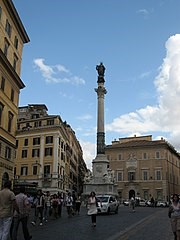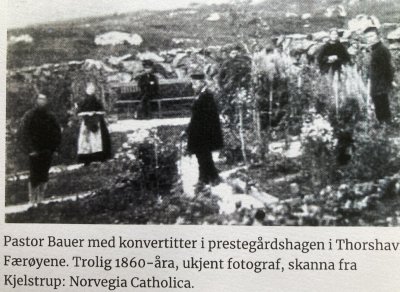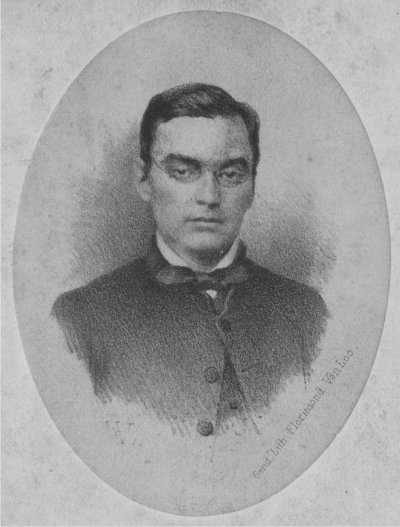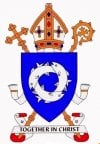North Pole Mission Clergy

Etienne Djunkowsky, founder of the North Pole Mission, dates its inception to 8th December 1854, the day Pope Pius IX proclaimed the dogma of the Immaculate Conception of the Blessed Virgin Mary in a solemn celebration in Rome which Djunkowski had witnessed. He had been inspired with the idea of a new mission to the extreme limits of the arctic circle, areas which had been evangelised a thousand years before but which had been lost to the Catholic Church in the three hundred years since the Protestant Reformation. Most of these lands were now Lutheran. Djunkowsky sought the approval of Pope Pius IX and was given encouragement to proceed. After a successful preliminary exploration in these northern lands, Pope Pius IX erected the Prefecture Apostolic of the North Pole which was placed under the special protection of the Sacred Heart of Jesus and the patronage of the Immaculate Conception of the Blessed Virgin Mary. This vast prefecture embraced the territories of six medieval Catholic dioceses and parts of arctic North America which had been more recently discovered and were inhabited by nomadic eskimos. Etienne Djunkowsky was nominated as the first Apostolic Prefect.
The first six missionaries were recruited in 1856, four of them were priests. On 4th August 1858, meeting at Malines, the bishops of Belgium, took a special interest in the North Pole Mission and encouraged the faithful of their dioceses (Malines, Tournai, Namur, Ghent, Bruges and Liége) to support it financially, setting up an association of the faithful with a subscription of one Franc a year for ten years. The Belgian bishops also asked the faithful to pray for the success of the mission and committed themselves to support the North Pole Mission for ten years (1858-1868). The Rev. X. Ciamberlani, of Beveren, near Antwerp, was appointed Procurator of the North Pole Mission, and M. De Pauw, lecturer at the Major Seminary at Malines, was made Treasurer General for the Work of the Mission in the archdiocese. The collection of funds was intended to supplement the aid already given by the Roman Congregation for the Propagation of the Faith.
The mission report of 1862, after Djunkowsky had resigned as Prefect Apostolic, lists eight priests in the order in which they had joined the North Pole Mission.
1. Very Rev Bernard Bernard, from the diocese of Rheims, Prefect Apostolic.
2. Rev G. Bauer, from the diocese of Ratisbon.
3. Rev A. Boller, from the diocese of Würzburg.
4. Rev A. Baudoin, from the diocese of Rheims.
5. Rev E. Maesfrancx, from the diocese of Ghent.
6. Rev Th. Verstraeten, from the diocese of Ghent.
7. Rev S. Moriga, from the diocese of Rome.
8. Rev J.M. Convers, from the diocese of Lyons.
Two other priests were due to join the mission in the near future.
In the 1865 report, Bernard says there were eight priests on the Mission, not including Rev S. Moriga who had returned to Italy in 1863. The Mission had in the first eight years of its existence lost more members than it currently numbered, only one of the losses was caused by death. Bernard blamed the extreme climate and the difficulties of the Mission. In 1865 the following priests were working on the North Pole Mission:
1. Very Rev Bernard Bernard, Prefect Apostolic, provisionally resident in Wick, Scotland.
2. Rev And. Boller, resident at Tromso, Norway. (Lapland mission).
3. Rev E. Maesfrancx, resident at Altengaard, Norway. (Lapland mission).
4. Rev G. Bauer, resident at Thorshaven, Faroe Islands.
5. Rev J.M. Convers, resident at Thorshaven, Faroe Islands.
6. Rev J.B. Baudoin, resident at Reykjavik, Iceland.
7. Rev E.M. Dekiere, resident at Reykjavic, Iceland.
8. Rev Th. Verstraeten, resident at Lerwick, Shetland Islands.
In 1865 there were also six seminarians for the Missions, studying in various seminaries.
In 1869 there were 13 priests working on the Mission and ten students, of whom two were due to be ordained in the summer of 1870. The nationality of the priests was: five Belgians (Rev Maesfrancx was at this point on leave of absence, but still attached to the North Pole Mission), two Bavarians and six French. The students included seven indigenous children.
Missionaries of the North Pole Mission.
PAUL MARIE ETIENNE de DJUNKOWSKY (1821-1870). He used the French form of his name (often Père Etienne) but in his native Russian was (Baron) Stepan Stepanovich Djunkowsky. His mother was from the Netherlands. Born near St Petersburg on 22nd February 1821, and so only 39 years old when he first came to Shetland. He was one of a group of Russian aristocrats in the circle of Prince Ivan Gagarin who were working to achieve unification between the Russian Orthodox and Catholic churches. They had all forfeited their lands by becoming Catholic and would have faced exile in Siberia if they had returned. In 1845, at the age of 24, Djunkowsky had joined Prince Gagarin in the Jesuit novitiate in France but left the order before ordination. He was ordained in Paris as a secular priest in 1852. Djunkowsky went to Rome in 1854 for the proclamation of the Dogma of the Immaculate Conception and was there recruited as the Prefect Apostolic (equivalent in authority to a bishop, but without the power to ordain priests) of the new North Pole Mission. Within months he had moved to Arctic Norway. We have no photographs of him but a contemporary account describes him as a stocky man, with a “barbarian” look, deep-set eyes, wide nostrils, large mouth and prominent cheek bones. He impressed acquaintances by his gift for languages (he spoke at least five), and his connections with Pope Pius IX and the Académie Française. In Belgium Djunkowsky established a base in Antwerp (c.1857-59) and was housed and supported by the Antwerp sugar magnate J. Dewyndt-Aerts. Djunkowsky has the distinction of having said the first post-Reformation Mass in Shetland (October 1860) but spent only a couple of weeks in the islands before returning to Orkney and Wick. Djunkowsky suffered a breakdown in health and abruptly left the North Pole Mission in September 1861. He was briefly excommunicated by Rome after marrying an Anglican Englishwoman but the marriage did not last and he was reconciled with the church. He lived in Germany for a while, engaged in literary projects, but reconverted to Russian Orthodoxy in order to recover his estates in Russia. He died there, aged 49, on 25th March 1870.

ABBE BERNARD BERNARD (1821-1895). Born in France 21st July 1821 in Mogues. Studied in Rome and was ordained priest in Rheims by Archbishop Thomas-Marie-Joseph Gousset on 5th July 1846. He joined the North Pole Mission at the suggestion of his bishop, who had a great respect for Djunkowsky. He had previously been a diocesan priest for a number of years in the Ardennes. Bernard was present at the opening of the Alta Mission, Norway, in 1856, but that same year was sent by Djunkowsky to Iceland to start the mission station there. He returned to France in 1858-59 on a fundraising appeal and was at that date described by Djunkowsky as his Vicar General. He arrived in Lerwick with Fr Theophilus Verstraeten on 7th October 1860 and received Mary Nicolson into the Catholic Church after Djunkowsky’s departure for Orkney. When Djunkowsky left the mission in October 1861, Bernard was appointed Prefect Apostolic and took up residence in Wick. In 1866 he transferred the headquarters of his mission to Copenhagen. Three years later the North Pole Mission was dissolved and Bernard was appointed Prefect Apostolic of Norway and Lapland with residence in Trondheim. While in Norway he joined the missionary order of Our Lady of La Salette, an order whose priests were assisting him in Norway, and when he resigned as Prefect Apostolic in 1887, he returned to France. His congregation assigned him to the Shrine of Notre Dame de l’Hermitage, near Noirétable (about 100 km west of Lyon) and he died there on 28th October 1895 at the age of 74. He was just a few months short of his Golden Jubilee of ordination. He is buried at the shrine. Like Djunkowsky, he was 39 when he first arrived in Shetland in 1860.

GEORG BAUER was a Bavarian priest from the diocese of Ratisbon. Bauer was with Djunkowsky at Alta in Norway at the beginning of the mission and from there was sent to Torshavn in the Faroe Islands in 1857. He was accompanied by an Italian priest, Luigi Mussa, who is not otherwise mentioned. At the time of Verstraeten’s arrival in 1859, he had been alone on the mission for more than a year. Bauer left the Faroes in 1872. In 1869 he was described by Bernard as the vice-Prefect of the North Pole Mission.
A. BOLLER was a Bavarian priest from the diocese of Wurzburg. Described as superior of the Lapland mission in 1859 and listed in the 1865 Scottish Catholic Directory as still resident in Tromso, Norway.
(A. in the 1862 list) JEAN-BAPTIST BAUDOIN (1831-1875). French, from the diocese of Rheims. Sent by Djunkowsky to Iceland in the spring of 1858. Assisted at first by Bernard Bernard, he was the first Catholic priest to minister in Iceland since the Reformation. Bernard left in 1862 but Baudoin persevered in the Iceland mission until 1875.
ELIAS MAESFRANCX (1819-1892). Belgian, from the diocese of Ghent. His brother was in 1859 parish priest of Peteghem-Deynze, near Ghent. Maesfrancx arrived in Lapland before October 1859 and was listed as Apostolic Missioner and Parish Priest in Alten-Talvig in Lapland, Norway, in June 1860. Still resident at Altengaard in 1865. He moved to Trondheim in 1866 and then travelled to the United States. Bernard announced in the 1869 report that Maesfrancx was taking some leave of absence because his health could no longer cope with the hard climate of Lapland, but he remained attached to the North Pole Mission and would seek occasion to return. From 1870-72 he was again in Trondheim, then returned to Belgium. In 1875 he moved to Detroit diocese, Michigan, in the United States and served in St Mary’s Church, New Baltimore, and St Charles’ Church, Newport until at least 1879. He returned to Europe and was living in retirement in Lourdes but died in Belgium in 1892.

THEOPHILUS MARIE VERSTRAETEN (1832-1871). Belgian, from the diocese of Ghent. Born in Bottelare, 27th December 1832. Ordained in Ghent 18th December 1858. He was recruited to the North Pole Mission while still a seminarian and seven months after ordination he was sent to assist Fr Bauer in the Faroe Islands (14th July 1859). With his arrival, donations from Belgium in support of the mission doubled from two years before in 1857. Fr Verstraeten spoke no German and was still very imperfect in Danish, so he and Bauer had to communicate in Latin. From the Faroes he was summoned to take over the new Mission to Shetland (7th October 1860) and remained as resident priest in Lerwick for eleven years until his death on 30th May 1871. He assisted elsewhere in Northern Scotland and in the Wick register described himself as “the missionary in Caithness, Orkney and Shetland”. He was buried in Bottelare on 9th June 1871. Fr Verstraeten was 27 when he came to Shetland and 38 when he died.
S. MORIGA. From the diocese of Rome. He left the North Pole Mission in April 1863 on medical advice, because of the effect of the climate on his health and returned to Italy.
LUIGI MUSSA. Italian. Accompanied Georg Bauer to the Faroe Islands in 1857 but left soon after.
P. BIANCHINI. Missionary priest stationed at Olafshaven (Altengaard) in 1859. Left the mission before 1862.
J.M. CONVERS, French, from the diocese of Lyons. Arrived in the Faroes in 1862 or 1863. He was in residence by 18th April 1863. Listed in 1865 Scottish Catholic Directory as assisting Georg Bauer at Torshavn in the Faroes.
EMILE MARIE DEKIERE. Belgian, from Roeselare. Joined the Mission between 1862 and 1865. Listed in the 1865 Scottish Catholic Directory as assisting J.B. Baudoin at Reykjavik in Iceland. Had been a student of Guido Gezelle’s at Roeselare seminary and been encouraged to join the North Pole Mission by him. He worked first in Iceland, from where he kept up a correspondence with Gezelle for a while. He published a volume of Apologetics in Iceland in 1865. From 1867-1874 he worked in Norway and in 1869 he was assisting the Prefect Apostolic in setting up a new house in Copenhagen.
J.P. CAPRON, appointed to Wick as Apostolic Missioner by Bernard in 1866 after the headquarters of the Prefect Apostolic was moved to Copenhagen. He had previously been working in Lancashire among the poor. In 1867 he was assisting Claude Dumahut in Wick and attending the Orkney Islands, which were without a resident priest. Still resident in Wick (serving Orkney three times a year) in 1872.
Rev VANWTBERGHE. Belgian, from the diocese of Bruges. Described as a “young missionary” in 1869. Based in Wick, serving also he Orkney islands periodically.
HENRICK BLANCKE. Belgian. He had passed through Roeselare seminary and been recruited for the North Pole Mission there. Blancke is remembered as a slightly eccentric man. He worked from 1868-1870 in the Faroes, then from 1870 – 1887 in Norway. His main work in Norway was the mission station of Halden (Fredrikshald), which he founded.
CLAUDE DUMAHUT, born in France. Listed in 1867 as missionary with Capron in Wick. In 1872 he moved to Norway and became the first pastor of the Catholic Church in Trondheim.
- - - - -DR OLAFUR GUNLOGSSEN was the only Scandinavian member of the mission and a convert to Catholicism from Lutheranism. He was an Icelandic layman who had studied for a doctorate at the Catholic University of Louvain. He was with Djunkowsky when he made his first journey to Arctic Norway in the Spring of 1856 and established himself at the Alta mission. His special contribution was to translate medieval Scandinavian literature to raise awareness of the Catholic heritage of the Nordic lands. His translation of a poem in honour of the Blessed Virgin Mary went through two editions in three months, the first published in Copenhagen, the second in Vienna. He accompanied Djunkowsky on his visits to the Faroes in July 1860, to London the following month and then to Shetland in September. He stayed on briefly in Lerwick after Djunkowsky sailed for Orkney and was present with Bernard at the reception of Mary Nicolson into the Catholic Church in October 1860. Soon after this he left the North Pole Mission. Djunkowsky gave him a letter of introduction to Cardinal Wiseman in London with the hope that he would find employment in a college or with a family. Gunlögssen had been considering ordination to the priesthood but from November 1860 pursued a secular career.



